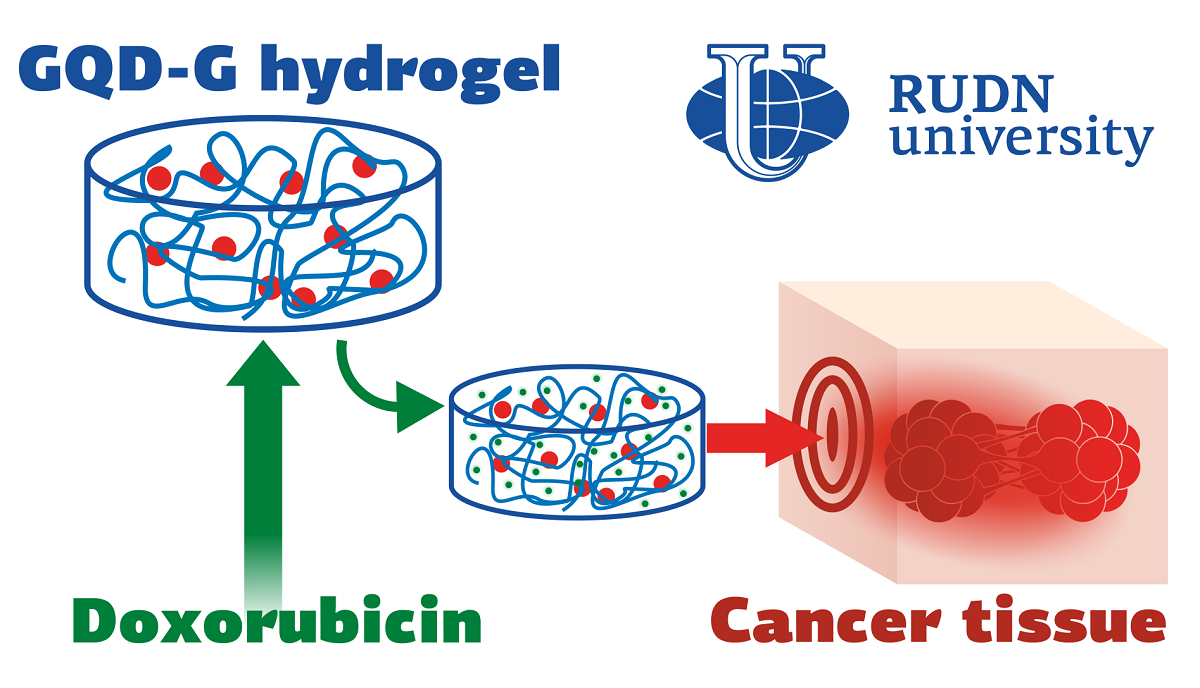Scientists Created a Tool for Targeted Drug Delivery to Tumor

One of the methods of cancer treatment is chemotherapy. Cytostatic drugs are usually administered intravenously, they help to minimize the growth of the tumor, but at the same time they put a serious strain on the body and cause side effects. Targeted drug delivery systems help improve the effectiveness of treatment and reduce side effects. However, there is no exact targeted delivery method yet. RUDN University chemists, together with colleagues from Iran, have proposed a hydrogel compound made of graphene and gelatin that can potentially deliver the anti-cancer drug doxorubicin to a tumor.
“It is important to introduce an alternative vehicle that can deliver anticancer drugs effectively in the targeted tumor tissue. Based on our previous findings in modification/functionalization of materials via multicomponent reactions we report a green, straightforward, and efficient novel method to prepare GQD-G hydrogel, which can be used as an implantable antitumor agent,” said Ahmad Shaabani, a leading researcher at the Joint Institute for Chemical Research of RUDN and SBU.
Chemists have created a hydrogel that can hold a drug and slowly release it as it dissolves. The GQD-G hydrogel consists of gelatin and graphene-based quantum dots. Quantum dots are semiconductor particles with electrons “trapped” in it. They were obtained by pyrolysis of citric acid. The solution with quantum dots was combined with gelatin and excipients (bromobenzaldehyde and cyclohexyl isocyanide) to form a hydrogel, a “vehicle” for the drug. Then they injected doxorubicin in it (a common drug used in cancer chemotherapy). Cytotoxicity of the drug was studied on breast cancer cells.
Within 100 hours, up to 25-70% of doxorubicin is released from the hydrogel compound, depending on the acidity of the environment and the concentration of auxiliary bromobenzaldehyde in the hydrogel. The ability to kill cancer cells in this compound was lower than that of pure doxorubicin, but the hydrogel complex provides another advantage. One can control the rate of drug release and reduce side effects, since the hydrogel with the drug can be injected directly into the desired tissue.
“The designed hydrogels may attract great attention to construct a safe system, having the potential to be employed as an implantable anticancer and bio-detection agent. In addition, we believe that the presented strategy could attract much attention from the community of material chemistry for the preparation of biomedical platforms thanks to its green chemistry principle,” said Ahmad Shaabani, a leading researcher at the Joint Institute for Chemical Research of RUDN and SBU.
The results are published in the journal Materialia. https://www.sciencedirect.com/science/article/abs/pii/S2589152921002362
The project to develop a cellular model of the placenta became the winner in the Scientific Materials category of the Young Scientists 3.0 competition, organized with the support of the Presidential Grants Foundation and T-Bank.
Ten scientific journals published by RUDN University have been included in the highest level of the state list of scientific publications, the White List.
Forests are not only the lungs of the planet, but also home to millions of species. However, it has remained unclear how underground interactions between trees and fungi affect forest species richness in different climatic conditions. Previous studies have yielded conflicting results: in some regions, the dominance of certain fungi reduced tree diversity, while in others it increased it.
The project to develop a cellular model of the placenta became the winner in the Scientific Materials category of the Young Scientists 3.0 competition, organized with the support of the Presidential Grants Foundation and T-Bank.
Ten scientific journals published by RUDN University have been included in the highest level of the state list of scientific publications, the White List.
Forests are not only the lungs of the planet, but also home to millions of species. However, it has remained unclear how underground interactions between trees and fungi affect forest species richness in different climatic conditions. Previous studies have yielded conflicting results: in some regions, the dominance of certain fungi reduced tree diversity, while in others it increased it.